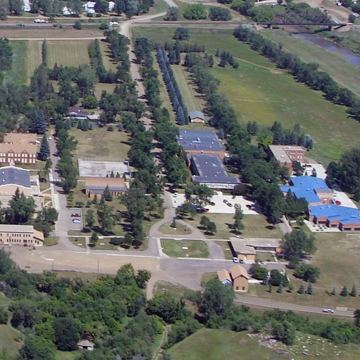You are here
North Dakota Youth Correctional Center (YCC) (State Industrial Training School, North Dakota State Reform School)
Established in 1903 as the North Dakota State Reform School, this campus is one of many state institutions to benefit from the master planning of Minneapolis-based landscape architects Morell and Nichols. Like many of the firm’s campus designs, this is a sensitive balance between the informality of the natural setting—here adjacent to the Heart River where a natural draw funnels down from surrounding bluffs—and the axial formality of a densely landscaped drive. Landscape plantings have been carefully implemented to form courtyards for many of the building groupings. In 1938, the State Industrial Training School became a youth correctional center offering high school classes, and one of only four juvenile justice centers in the nation that housed both boys and girls. The current campus includes four cottages, administration and education facilities, gymnasium with indoor swimming pool, chapel, and cafeteria, all designed by North Dakota architects. By converting one cottage into a secured facility for high-risk juvenile offenders, the campus avoids enclosure with a conspicuous wall or security fence. The facility was renamed the North Dakota Youth Correctional Center in 1995.
In 1923, the State Industrial Training School acquired a 634-acre farmstead located west of its main campus, called Sunnyside Farm. It allowed the school to greatly expand its agricultural vocational training and each year a small group of students from the school was selected to live and work at the farm. In 1926, after the barn on the newly acquired property was destroyed by fire, the staff designed a replacement structure that was built by the students. The new building was touted as a model dairy barn and quickly became the central focus of the school’s agricultural activities.
Writing Credits
If SAH Archipedia has been useful to you, please consider supporting it.
SAH Archipedia tells the story of the United States through its buildings, landscapes, and cities. This freely available resource empowers the public with authoritative knowledge that deepens their understanding and appreciation of the built environment. But the Society of Architectural Historians, which created SAH Archipedia with University of Virginia Press, needs your support to maintain the high-caliber research, writing, photography, cartography, editing, design, and programming that make SAH Archipedia a trusted online resource available to all who value the history of place, heritage tourism, and learning.






